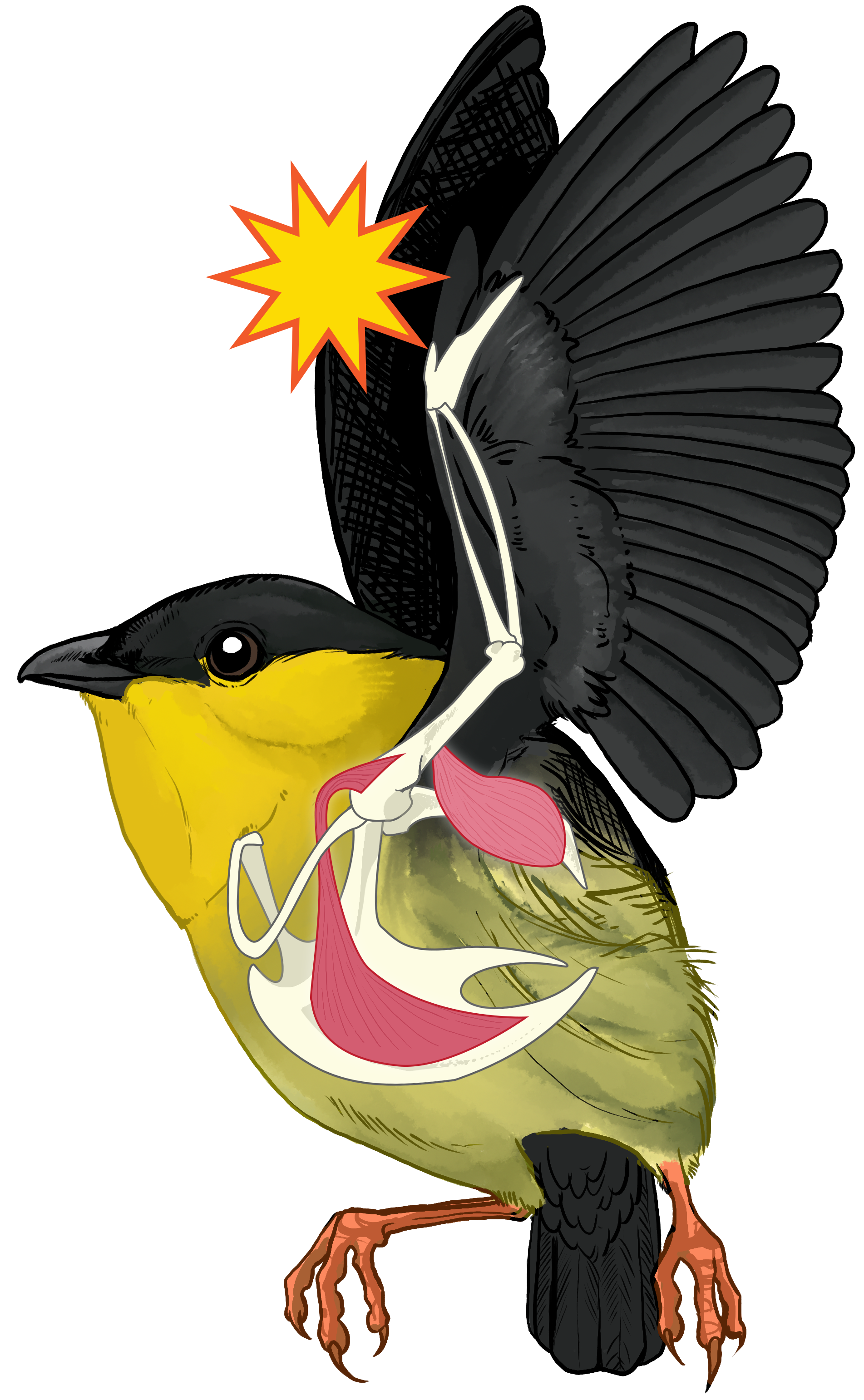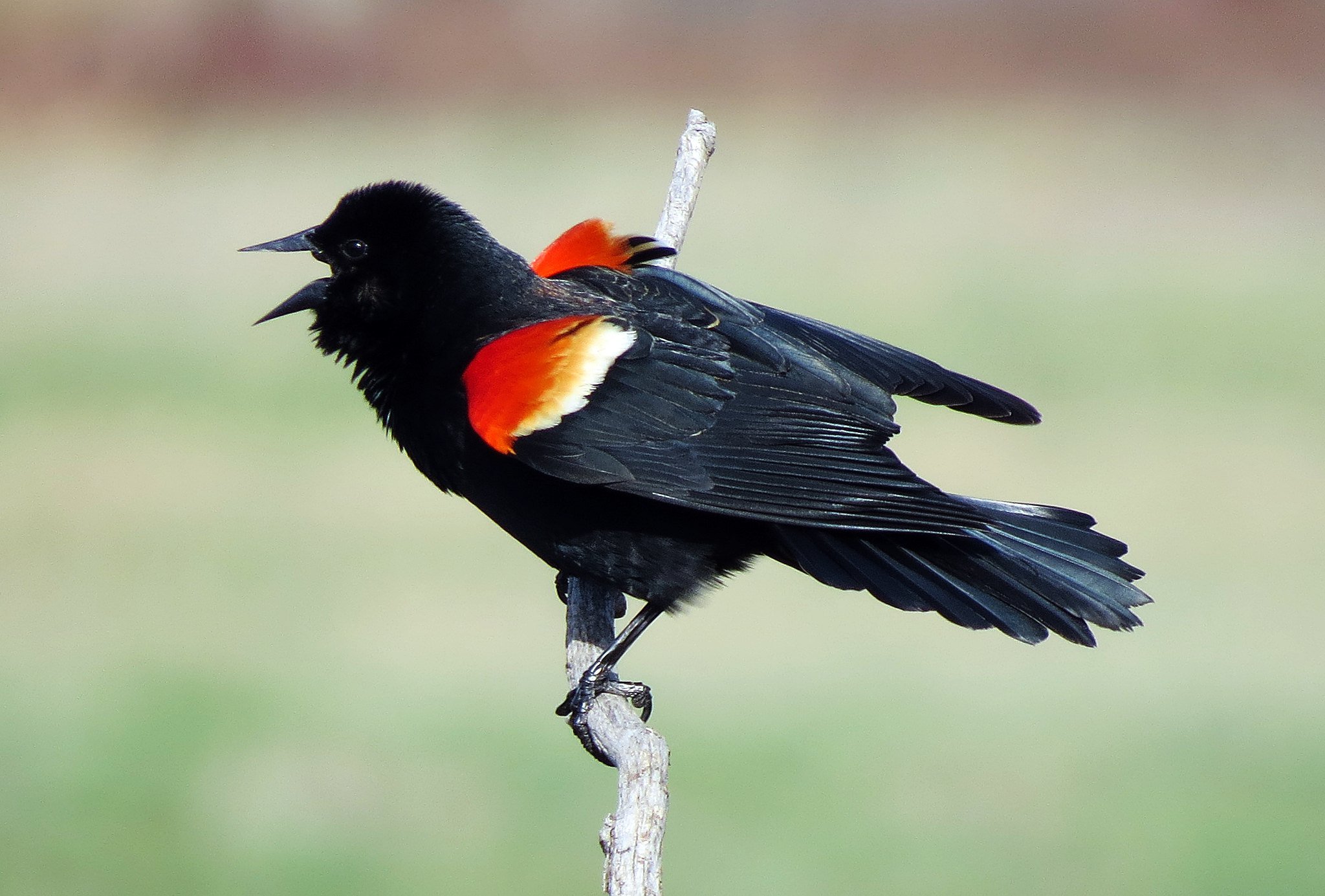Research Program Overview
Folks in the Fuxjager lab study how animal behavior evolves. We are especially interested in the unusual displays that animal use to court mates and compete with rivals, particularly dance displays. Our work is highly integrative, in that it combines conceptual and technical approaches from a wide range of disciplines. This includes genomics, molecular physiology, whole-animal physiology, neurobiology and endocrinology, animal behavior, comparative phylogenetics, and systems biology. We try to stay open to new ideas, new species, and new approaches, with the assumption that this openness forms the basis of exciting, paradigm-shifting discoveries.
Evolution of extraordinary performance abilities
A golden-collared manakin, which we’ve studied extensively. Males court females by hammering their wings together above their back and by performing a rapid dance on the forest floor. Hormones like testosterone mediate the speed of the muscles that actuate these display moves, even transforming some muscles into tissues with “superfast” twitch speeds! Image from Fuxjager and Schuppe (2018) J. Steroid Biochem. Mol. Biol.
A major goal of the lab is to better understand how a species’ physiology supports the ability of selection to drive evolutionary innovations in behavior. We study this topic by assessing how endocrine, musculoskeletal, and neural systems evolve to accommodate (or hinder) the emergence of behavioral traits.
We do a lot of this work in manakins birds. In this spectacular avian family, males tend to court potential mates by performing elaborate dance routines. Many of these behaviors hinge on the production of extraordinary or extreme bursts of performance. In this way, many manakin display seem to exceed the species’ performance abilities, or at least those performance abilities we would normally ascribe to a small bird. Selection for these displays therefore likely drives the evolution of certain physiological systems, especially those systems that underlie movement. Such effects presumably endow individuals with novel performance abilities that can facilitate appropriate display performance. Our research interrogates these physiological specializations to determine what they look like, and how they confer new ways of producing behavior.
The lab studies similar types of questions in other species, such as woodpeckers and frogs. Of course, while it may appear as though the lab is having a taxonomic identity crisis, we actually try to be thoughtful in the species we use to address a given question. Manakins, for example, are good for studying behavioral novelty, since the species within each genus have evolved their own display routine that differs dramatically from other species in other genera. Woodpeckers, on the other hand, are ideal for large-scale comparisons of display diversification. This is because nearly all of these birds produce variants of the same social display (drumming). Finally, the frogs we study are great because they represent a group of anurans that are distantly related to each other, but have convergently evolved the same display. In this group of animals, we can therefore assess whether parallel physiological mechanisms evolve to underlie the process of convergent evolution. Overall, we’ve uncovered a wide range of traits that likely co-evolve with elaborate dance displays and gestural signals, including specialized brain regions, “superfast” limb muscles, hormone-making muscle tissues, unusual bone morphologies, altered endocrine signaling machinery, etc.
This is an Indian dancing frog! Males fight with each other by performing foot flags, which are slow waving displays produced with the hindlimb. Working with others (Doris Preininger at the Vienna Zoo and Lisa Mangiamele at Smith College), we’ve found out a wide range of cool things about how this behavior evolves. Namely, the muscles that mediate this display appear to be very sensitive to hormones like testosterone, which acts in the brain and body to influence the signal’s geometry. In effect, higher levels of circulating testosterone likely make males produce a more circular display, and this effect appears to be better at scaring off rivals. Photo from Doris Preininger
Of course, the species mentioned above are not the only ones that we’ve studied. Our work has spanned a wide range of other animals including, birds of paradise, toucans, barbets, Asian common toads, Lake Titicaca frogs, etc. The list is only growing! Most importantly, we’re interested in findings the right species for a given question, and most of us in the lab have experience working with a wide range of taxa. This makes for a very fun and exciting intellectual environment because everyone has such different backgrounds and perspectives.
A male downy woodpecker. We’ve been studying these little angry birds for a long while, focusing on their territorial strategies. We work mostly in free-living populations here in Rhode Island. Photo by Flyn Kynd
Territorial dynamics in free-living woodpeckers
A longstanding interest of the lab is to better understand animal territoriality. We are especially interested in how individuals produce behavior to fight off rivals, and how past experiences during territorial encounters influence future behavior. We’ve begun to study territorial tactics and strategies in free-living woodpeckers. While it appears on the surface that woodpeckers have highly variable territorial behavior, we’re starting to see that their territorial performance is actually quite well organized in the more specific tactics that individuals deploy in different contexts. Folks in the lab are interested in studying what these tactics looks like and how they are used, as well as the way the brain controls them.
Figure from Moody et al. (2025) PLoS Comp Biol that shows a simple behavioral network representing the aggressive behavior male and female residents express during a simulated territorial intrusion. Using spectral clustering and transition analysis, we can elucidate behavioral motifs that likely represent tactical choices birds are making during a fight. See our publications for more information.
One approach we’ve used to address these issues is called spectral clustering. This methods helps us tease out the behavioral motifs that male and female resident downy woodpeckers produce when fighting off rivals. From there, we can identify how social mates "coordinate” aspects of their behavior with each other when expressing these motifs. Currently, the lab is interested in studying these clusters of behavior (which we think represent tactics) more carefully, determining how and why they vary through through space and time.
Evolutionary ‘construction’ of elaborate dance routines
In the past, the lab has investigated the evolution of elaborate gestural displays in New World blackbirds. This red winged blackbird has an iconic wing display, which was incorporated into our study showing that temperate blackbirds perform more complex physical display routines. Photo by Robert Pruner
Sexual selection is well known for producing bizarre display behaviors that showcase amazing colors, sounds, and movements. But, how does such complexity arise? Another goal of the lab is to better understand this process by uncovering the evolutionary mechanisms that underlie the emergence of especially complex animal displays. We explored this in a wide range of ways, often relying on different comparative phylogenetic methods.
This line of research has a few objectives. First, we are interested in understanding the evolutionary order of operations for complex behavioral evolution. When, for instance, and animal evolves a courtship dance, does it gain all the dance traits at once, or do these dance traits slowly arise through time and collect into the routine we currently know and see? If the former is true, then we are interested in understanding which components of the display come first, and whether their emergence influences the evolutionary gain or loss of subsequent display traits. In this way, our goal is to map out how complex displays can not only arise, but also diversify by accumulating and losing behavioral “bits and pieces.”
Results from one of our papers exploring how tail cocking displays evolve in toucans and barbets. From Miles and Fuxjager (2018) Am Nat.
Our second objective is to understand how physiology fits into this process. We’ve found, for example, that phenomenological signatures of sexual selection positively predict species differences in drum length across the woodpecker, but they do not predict species differences in drum speed. Rather, speed appears to be constrained by mechanical and/or scaling features of body size, such that big birds drum more slowly. More recent studies done in the lab show that relative brain size in woodpeckers influences how their foraging tactics might evolve. Indeed, the ancestors of these birds likely had a large brain relative to their body size, and maintaining this trait appears to be key to innovations in extractive foraging.





